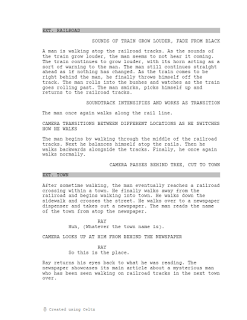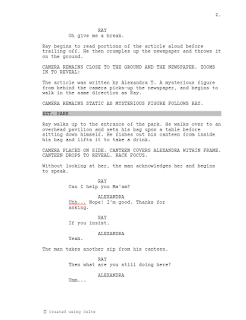Over the past couple of weeks I have worked to complete the pre-production work for my next film. It was difficult to work as much as I would have wanted to do on pre-production since I've also been working on my Eagle Scout project as well as doing work for my internship, Mini-THON, and other classes. Despite this, I feel that I have gotten a large amount of preparation completed and I am in good position to begin production. The following is a brief synopsis of my pre-production work.
Concept
For this project, I decided that I wanted to keep things relatively simple overall. I wanted a limited amount of characters, locations, and plot details. I made this decision to hopefully make this film an easier task than what I had envisioned for my previous film. The idea for this film came to me when I was listening to a whole bunch of old country and wild west styled songs. From them, I decided to have the story follow a cowboy/drifter character. While I likely could've taken this idea in the direction of action, I figured that making it a love story would be easier for me to produce well. A love story can work with as little as two characters, which allows me to focus more on two good characters than multiple other weaker characters. A love story also doesn't require a large amount of locations, once again helping make this production simpler. Lastly, a love story usually only follows the two main characters, which once again lets me keep the overall structure of the film simple.
Script
I typically do not enjoy script writing, and writing this script was no different. Usually, I end up changing a large portion of the dialogue once I finally arrive on set with my actors. The draft that I currently have will definitely not be the same as seen in the final product. With this film being a love story, it involves a large amount of dialogue. Despite this I really wanted to make sure that there were times within the film that no dialogue would be spoken, in order to give the audience some time to breathe between discussions. My opening scene features no dialogue and I hope it works to teach the audience about the main character without it's inclusion. The third scene is where the dialogue between the two main characters begins. As said before, this dialogue will likely be changed once on set and by having the actors read it aloud, I should hopefully be able to tweak it to sound more "human". The first two pages of the script are included below to give a sneak peak as well as context to what I just mentioned.


Storyboard
When it comes to storyboarding, I tend to have an idea of what I want scenes to look like but not specific shots. If a scene involves two characters sitting at a table and talking, I know how to show the audience the scene but not with many different camera angles. Similar to what I do with script writing, I tend to change whatever I have whenever I am physically on location with my actors. The exception to this is more intricate and action filled scenes. My first scene involves some action for my main actor, so storyboarding it out is necessary for a good performance. The storyboard for this first scene can be found below at this link.
Casting/Locations/Miscellaneous
As of now, I have most of the rest of pre-production duties settled. I have one actor confirmed to be helping and who is available to film whenever I schedule days to shoot, and other who will hopefully be able to be confirmed soon. I have chosen locations for each scene, however some locations will need to be decided upon. For instance, one scene takes place within a public park. I have selected a few public parks within my area around me, however, I just need to decide on which one to film at. Likely, these decisions will be made on days of shooting based on external factors (people at locations, weather, etc). Each location is either public property or a space that I occupy, so no location releases are needed for this film. A prop list and costume list has been created and I have already been working to scrounge up each item on the list as I find them.


Comments
Post a Comment